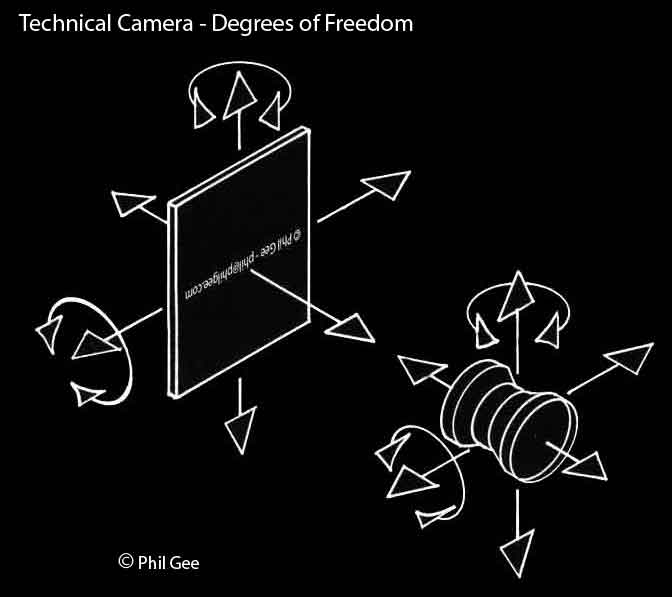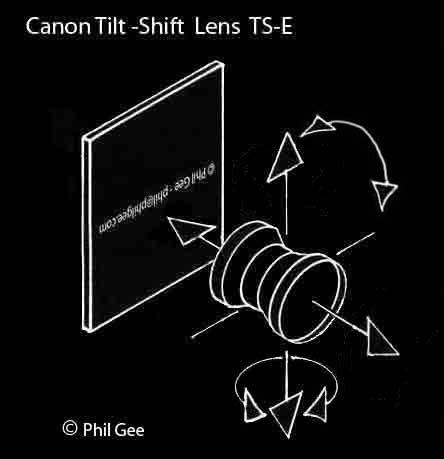Technical Camera Movements applied to Tilt-Shift lenses

Nomenclature Technical Camera movement of Film and or Lens Standard
Rise and Fall - Vertical movement
Shift - Horizontal movement Left or Right
Tilt - Up or Down
Swing - Horizontal Left or Right
A number of Technical Camera manufacturers produced scaled down versions of their large format cameras to take advantage of the new Medium format Digital Backs in place of 6x6 and 6x4.5 film backs e.g. Sinar's P3, Cambo's
With the rapidly increasing pixel count of sensors, approaching film quality; this design enabled 35 mm DSLR users to gain more of the benefits reserved for Large Format users at a fraction of the price, without the bulk but it is not as compact as the DSLR-Tilt-Shift lens.
DSLR - Tilt - Shift lens
The DSLR Tilt-Shift Lens is an adaption of the movements normally associated with large format technical cameras to small and medium format cameras, you are able to move the lens along a plane parallel to the Film as well as angular movements about its nodal point (Swing and Tilt) The Film or Sensor remaining in a fixed position.
Not all camera manufacturers use the same arrangement but in all cases the Film or Digital Sensor is in a fixed position Tilt, Swing and Focusing movements are carried out within the lens mechanism which can be rotated through +90˚ -90˚ enabling Tilt to become Swing and Shift to become Rise or Fall
Lens movements for the Canon TS=E (Format 36x24mm) are shown below.

Canon lens as a 'Swing - Rise-Fall' index it through 90˚ and it will be in the Tilt - Shift configuration
To keep the units compact the lens movements are limited to one Swing and one direction of Shift however the lens assembly can rotate so a Vertical Shift (Rise or Fall) can become a Horizontal Shift and a Horizontal Swing can become a Vertical Tilt (Swing is called Tilt when its Vertical ) by rotating the lens assembly.
With the Canon design it is possible to convert the lens to a Swing - Shift ( Tilt - Rise and Fall) and on the latest lenses this is user selectable
Simultaneous Tilt and Shift is possible but limited to only one direction of Shift (Rise and Fall) and Tilt or Swing
Whist this is a limiting factor these Tilt-Shift lenses have enabled 35mm and Medium format DSLR users to gain some of the advantages of studio photography without the bulk of a Technical or Field camera.
Vertical Shift (Rise)
Both the images below were shot with a 35mm full frame digital camera, using a Canon 24mm TS lens, hand held from the same camera position.
In the first shot the lens was set as a standard lens which necessitated tilting the whole camera upwards in order to include all of the building; resulting in the top of the building being narrower than the bottom on the film plane giving the appearance the building is leaning away from the viewer.
In the second image the camera was held parallel to the building which cropped the top off the and gave plenty of road so the lens was 'shifted' upwards until the Chimney stacks were visible, you will note that the vertical lines in the subject remain vertical
Whist it is good practice to use a tripod and bubble level to ensure film plane is vertical and horizontals true, acceptable results can be achieved by using a monopod or even hand held. A focus screen with a rectilinear grid is a fantastic help in keeping verticals, vertical.
You can apply perspective correction out of camera in Photoshop but if you are using 35mm digital cameras you are wasting pixels. Granted studios who used technical cameras for pack shots etc have been moving to post processing methods but they have down graded from 4x5 to medium format or 35mm with TS lenses.
Tilt (and Swing)
Whilst they are called Tilt-Sift lenses they Swing as well
Tilt is when you pivot the lens vertically and Swing when it is pivoted horizontally
The relative orientation of the 'film' plane to the subject determines the distortion of same on the 'film' plane, the movement of the lens determines coverage and depth of field
TBC...